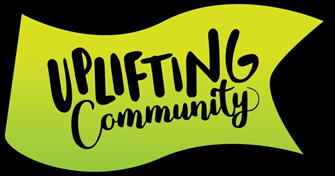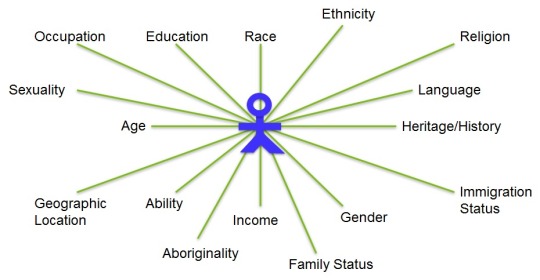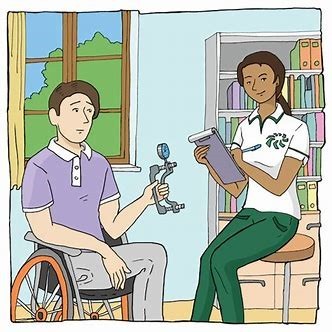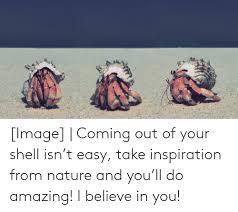Don't wanna be here? Send us removal request.
Text
The Ongoing Journey of Enhancing My Skills as a Future Occupational Therapist.
This is an ongoing path of learning and unlearning some of the aspects that will mold myself into a better therapist. My greatest challenge was moving from a hospital-based setting to a community setting. In the hospital, there’s easy access to patients or clients and being able to access their medical history. In the community, most of the clients refuse our assistance which makes our duty to intervene difficult.
To overcome that challenge, I had to adapt and find my feet in the community setting, by allowing myself to be the most flexible. Working on my positionality to be able interact with the community which involves respecting their beliefs and culture in order to build a rapport with them. During one of my home visits, I was told I can’t enter the premises with trousers on. I had to respect their beliefs and wrap a towel around my waist and be able to continue with my duty without overstepping any boundaries.
Being resilient is one of the important skills an OT should have. I see different people everyday at the clinic and those people come from different backgrounds. It is in my best actions to actually be aware of such. Understanding not everyone will react the same when approaching them but be able to maintain control of that situation by thinking of new ways of approaching them. If you want to keep track of your life and work, you absolutely need to learn how to successfully deal with difficult times (Elizabeth, 2020) This also allows for a better interaction and enables them to share their burdens with me, as I try by all means to create a safe space for them.
This leads to advocating for them, as most of them are facing social issues. As much as some of the issues are beyond my control as an OT but finding ways to assist with resolving the issues is the best I can do. Looking for initiatives to provide support which will place those you are helping in advantage, regardless of the profession (Ram, 2019) But not only we are advocating for clients, also our profession. It is important to make people aware of we do. Everywhere we go, we need to advocate as we are misunderstood, and some people find it hard to comprehend the concept of OT. To be eloquent, we explain what we do in simple terms for each individual to be familiar with this profession.

Figure 1 Why Advocate?
(FET: Advocacy Steps: The Essentials, 2018)
This has been an eye-opening block and a great way of interacting with people in their own space. I got to understand the importance of context and environment in our profession. It allows for realistic modifications and adaptations for the client, which enhance the client’s optimal independence. As I am still learning, I am allowing myself to adapt and inherit traits for growth. The quote by Gary relates to me as I feel the best way to improve is by learning new things.

Figure 2 Reinventing Yourself
(Reinventing Yourself Quotes, n.d.)
References
Elizabeth, A. (2020, November 26). What is Resilience and Why is it Important for Success? Retrieved from LIfehack: https://www.lifehack.org/715558/what-is-resilience-and-how-to-be-resilient
FET: Advocacy Steps: The Essentials. (2018, June 20). Retrieved from The Arc: https://lwarc.org/event/fet-advocacy-steps-the-essentials
Ram, S. (2019, August 16). Four Things I Learned about Occuaptional Therapy Advocacy as a Federal Affairs Intern. Retrieved from AOTA: https://communot.aota.org/blogs/sue-ram1/2019/08/16/four-things-i-learned-about-occupational-therapy-a
Reinventing Yourself Quotes. (n.d.). Retrieved 2021, from Top Famous Quotes: https://topfamousquotes.com/quotes-about-reinventing-yourself/
0 notes
Text
Uplifting the community using the sustainable developmental goals

(Uplifting Community, n.d.)
By uplifting the community, I mean providing the society with strategies to overcome their barriers more especially those affecting their well-being and functioning at home as my aim is to improve the clients’ ability to perform their daily activities and meet their needs. We have Sustainable Development Goals (SDGs) to improve such areas and more globally. Let us first give the meaning of this term before we unpack some of these goals. According to the WHO definition, “the Sustainable Developmental Goals are a call for action by all countries – poor, rich and middle income – to promote prosperity while protecting the planet.” We have 17 SDGs, but I will be focusing on five of them on how I can implement them within the community.
Goal 3: Good health and Well-being, this goal ensures that every human being is able to enrich their knowledge through promoting health and ways to improve their well-being. I can achieve this by encouraging Health Seeking Behaviour within the community members by improving their understanding of health which is not just the absence of illness but rather to highlight health in terms of mental health, interactions and integration into the community. An attitude towards health is essential for sustaining a healthy lifestyle for a long time (Sabhlok, 2018). Doing health promotions at the clinic is how I can get through the community members and explaining our Role as Occupational Therapists of which will assist to be aware of different conditions and areas that might need intervention on.
Goal 4: Quality education. We all have a right to education, but we have a responsibility to ensure we learn, do our best and be cooperative in order to achieve our goals. Education is one of the principal elements that permit humans to develop as individuals. It teaches humans vital existence, and it opens their thoughts to quite a few thrilling components of existence (The Importance Of Education In Our Society, 2018). Within the community, I visit schools to provide intervention to learners who are battling with their schoolwork. Understanding how important education is, this propels me to give it my best when providing treatment which will allow them to perform better in class.

(Dysgraphia, n.d.)
Goal 5: Gender Equality. No gender should be more superior than the other, opportunities should be presented equally to all humans. From my point of view, this goal is one of my favourites. I feel that as women we are not heard enough and not given the same respect as men receive. Encouraging women empowerment has a positive impact on reducing gender inequality. Achieving this goal means encouraging women to stand up for themselves and believe in their abilities of achieving greater things.
Goal 15: Life on Land. The Inanda Wilderness Park is a nature-based open space where we work at. It is amazing to work at a different setting other than a health facility, working at park has helped me appreciate nature more as we try by all means to do nature-based activity. At the clinic, I always encourage people to come and experience the greatness of nature.
Goal 17: Partnerships for the Goals. We are working with the Lay Counsellor from Health Systems Trust at the clinic as we have a shared vision of insisting hope to the youth and addressing mental issues they might be facing. This is an informal partnership of which was formed as we saw a need to focus on such issues. We are going to have support groups for the youth which will give them a platform to express themselves in order for us to aid in those areas they are battling with. Our skills come in handy as we will share stress management tips, ways on improving self-esteem, career guidance and so on. These support groups we are hoping that they make a difference within the society.
These above goals work hand in hand to make the community better. The best way to achieve them is by in cooperating them with the OT skills I already have by providing optimal and equal intervention depending on the individual’s needs. Creating a better space for the society to excel is what I wish to do and by this my heart would be full.
References
Dysgraphia. (n.d.). Retrieved 2021, from Child Success Center: https://childsuccesscenter.com/home/services/dysgraphia-struggles-with-handwriting/
Sabhlok, P. (2018, August 29). The importance of a health seeking behaviour. Retrieved from Health for the community: https://healthforthecommunity.wordpress.com/2018/08/29/the-importance-of-health-seeking-behaviour/#:¬:text=The%20attitude%20of%20health%20health%20seeking%20behaviour%20is%20Paramount,it%20off%20bud%20what%20is%20essential.
The Importance Of Education In Our Society. (2018, February 19). Retrieved from Education News: https://www.educationviews.org/the-importance-of- education-in our-society/
The World Health Organization. (2008). Sustainable Development Goals. Switzerland.
Uplifting Community. (n.d.). Retrieved 2021, from The Cause Collaborative: https://www.thecausecollab.org/upifting-community
1 note
·
View note
Text
The Journey of Developing My Positionality
Positionality is the concept that personal values, opinions, and time and space affect one’s understanding of the world. In this case, race, gender, class, and other characteristics of identity are indicators of social and spatial status (Sanchez, 2021). Learning one’s position in society is important. I grew up in a lower socio-economic where a woman is seen as a wife, who must take care of kids, clean and cook while the man goes to work and provide for the family. I was raised by a single mother, who had to work hard to provide for me as my father chose to let her be a single parent by leaving us. Through all the that, I saw the importance of being an independent woman. My mother always encouraged me to go to school and become something so I can never rely on someone to feed me, which is why I am on this journey of becoming something great.

(Intersectionality & Personality, 2015)
Occupational therapists have a responsibility to assist patients/clients to enhance their capability to function their desired activities and characteristics as independently as possible (Stromsdorfer, 2020). By doing this, as therapists we also need to understand our position within the environment, we are working in. As many clients let us into their world, by this I mean opening up to us, but we must respect the person’s beliefs and personal values they have. This is allowing for the therapist and clients to build a rapport which will allow for treatment to occur. When I am screening at the clinic or seeing clients at the park, I ensure to speak IsiZulu and basic concepts as possible for them to understand what I do.
I am fortunate enough to understand where most people are coming from as I am also from a lower socio-economic. This promotes the way I approach the people at Inanda Seminary clinic. I allow the client to share their difficulties and their situation at home without having them feeling like I am more privilege than them or above them. When working the community, you are actually within that person’s space. This is a big transition from the hospital setting to the community setting. By being in the community, I need to be informative about the dynamics of injustice, discrimination and oppression, therefore understanding the effect of economic deprivation on populations-at-risk and limitations of receiving proper healthcare. This made me realize that there is still a lot of work that need to be done to uplift the community.
The projects and programmes we do at Inanda Wilderness Park are based what the community needs. These projects benefit the whole community as we treat babies to elderly people, this is more of giving back to the community. Ames (2021) stated that this is also a great to learn more about the community and the people living there. This is an opportunity to help us understand better the situation of others in the community. When working with people who are interested in what you are doing, it allows for better improvement. A fair and broad view of your surrounding will also help you become an effective and compassionate citizen.
In general, when I consider my position, I still think there is a lot that I still need to learn. However, I came to a conclusion that growing in the lower socio-economic environment also affects how you see the world. Some people are resistant to the services we offer as they think we are intruders who came to change the way they are living rather seeing us as humanist we wish to see the community developing and improving from the challenges they are facing on their own. this is what drives me to actually want to continue learning and understanding not everyone will be open to change.
References
Ames, M. (n.d.). The Importance and benefits of giving back to your community. Retrieved 2021, from EF Academy Blog: http://www.ef.com/wwen/blog/efacademyblog/importance-giving-back-to-your-community/
Intersectionality & Personality. (2015). Retrieved from Zella Elliot: https://www.zettaelliott.com/intersectionalty-positionality/
Sanchez, L. (2021). Position/Positionality. Retrieved from New Discourses: https://newdiscourses.com/tftw-position-positionality/
Stromsdorfer, S. (2020). The 13 Most Common Occupational Therapy Setting. Retrieved from My OT Spot: https://www.myspot.com/occupational-therapy-settings/
0 notes
Text
The significance of maternal and child health within the society: implications for Occupational Therapy practice
Every day, mothers face a lot of issues during pregnancy and post-natal period. Some go through emotional breakdowns as they have little to no support from their families. The World Human Organisation (1979) defines maternal and child health services as “promoting, preventing, therapeutic or rehabilitation facility or care for the mother and child.” This is to ensure the health of mother and child in order to lead a normal life. It is said that it takes a village to raise a child but not many communities follow that phrase anymore of which affect the upbringing of a child especially if the household is struggling.
In most communities, we have a lot of young mothers who struggle to maintain their health while looking after the child. After giving birth, it is mostly about the child and not the mother. Everyone pays attention to the child, forgetting to check up on the mother. This seems to be one of the major issues, which makes the maternal and child health services to be more necessary within the community. Other issues include being far from the clinic, malnutrition or/and lacking knowledge about pregnancy (especially with teenage mothers).

Figure 1 Barriers to Anternal care in South Africa
(AmnestyInternational, 2014)
During pregnancy, a mother should be able to have access to health services, this gives a chance to determine and point out any health risks which might cause complications to both the mother and the child. Early intervention will have a positive impact on the prognosis. This is also emphasized by (Maternal, Infant and Child Health, 2020) that early detection and treatment of delayed milestones and other health conditions can prevent death or disability enabling babies to achieve their full potential.
As Occupational therapists, we have a vital role in maternal and child health care. (Payne, 2019) highlighted that “Occupational therapists have an important contribution to make to the health and well-being of women during pregnancy and in the postnatal period.” She additionally added that OTs assist the new mothers with physical and mental health problems, we also see premature, disable or unwell babies but our role is still not recognised more especially at the community setting. According to (Sepulveda, 2019) occupational therapists are equipped to screen mothers for maternal psychological state disorders and plays a vital role in overcoming gaps in maternal mental health care and providing the required support each mothers and children which will influence their health outcomes and therefore the well-being of the family.
For people to be aware of what we do, we must explain what we do through health promotion talks at Inanda Seminary Clinic every morning (Monday-Wednesday). From what I have observed there’s lack of knowledge regarding child development. A mother I once saw started mentioning a few things her child is not doing of which she thought were normal as she was not aware before the expected developmental milestones, I shared with her. Not only is this an issue, but new mothers also need support to cope with challenges that come from motherhood. This may include having support groups for new mothers to share tips on how to cope with stress, time management or self care tasks. I feel that a happy mother equals a happy child, this suggests that the child can sense their mothers’ emotions.
At the Inanda Wilderness Park, I believe that there could be a change through the Blaumeier project. The mothers can come to park with their children and have a support group of which they can encourage each other and encourage them that their health is as important as their child’s health. This could uplift their spirits and allow them to focus on their mental health and have a breather while experiencing the fresh atmosphere at the park.
The value of occupational therapists should be emphasised within the community. The role we play is very crucial and can benefit the community in so many ways. With the work we do, I’m hoping a lot of mothers will be able find balance between motherhood and taking care of themselves with other daily responsibilities allowing them to lead a productive and meaningful lives.
References
AmnestyInternational. (2014, October 30). Struggle for maternal health: Barriers to antenatal care in South Africa (October 2014). Retrieved from Polity: https://www.polity.org.za/article/struggle-for-maternal-health-barriers-to-antenatal-care-in-south-africa-october-2014-2014-10-30
Maternal Health. (n.d.). Retrieved May 06, 2021, from World Health Organization: https://www.who.int/health-topics/maternal-health#tab_1
Maternal, Infant and Child Health. (2020, August 10). Retrieved from HealthyPeople.gov: https://www.healthypeople.gov/2020/topics-objectives/topic/maternal-infant-and-child-health
Payne, S. (2019, July 03). The role of occupational therapists in the maternity care pathway. Retrieved from Royal College Of Occuaptional Therapists: https://www.rcot.co.uk/news/role-occupational-therapist-maternity-care-pathway
Sepulveda, A. (2019). A call to Action: Addressing Maternal Mental Health in Pediatric Occuaptional Therapy Practice. Annals of international Occupational Therapy, 2(4), 195-200.
0 notes
Text
Advice to future self as a person and as an OT

Life has been interesting, crazy, fun, boring, unexpected, expected—a lesson in opposition.
Despite all the constant frustration, you’ve managed to wear glitter each damn day, and hey, that’s kind of a victory, right? Your clothes are always on point—tons of fantastic outfits.
As you still age, you’ll continue to get additional awesome. Remember, the goal is to peak at ninety (or later). You’ve got heaps of time.
Despite the frustration, you’re on your path to creating all of your dreams come true (probably).
Be adaptable. Being an OT needs somebody who is nice at human activity and works well with others, particularly having the ability to speak along with your consumer and/or their families/caregivers. bear in mind what you're doing ought to be a collaboration on the simplest wants of the client and what they want, whether or not you have got just one session or multiple sessions to figure with, this can be one among the core values of therapy.
Also, prepare to be adaptable, creative, and showing emotion prepared as this field is jam-packed with surprises. Multi-tasking, exhausting work, and a focus to detail also are traits that you just should begin to develop now, not later!
Keep killing it.
0 notes
Text
In a nutshell – coming out of your shell and beyond
For me coming out of your shell means being comfortable around people and partaking in social activities.
Well, where do I start? Let me just say a bit about the type of person I think I am. I’m an outgoing, open-minded, kind, and well-mannered person. So, I would say I’m not really in a shell I can say halfway out of my shell if that makes sense. I have my moments; I think we all do where we just want to be alone and quiet for our peace of mind.
Now let me take through my journey of becoming an OT, this is not an easy ride but somehow, I’m managing. Becoming an OT is one of the biggest challenges I’m dealing with right now, don’t get me wrong. It’s a great challenge, I’m enjoying the experience. It challenges me to become more vigilant, allows me to think beyond what I see. And to me, this is helping me reveal things I never thought I’m capable of. The more I engage in the different tasks given to us as students, is the more I get express my true self which helps me grow and be more willing to learn. I just finished my Telehealth block. This was a refreshing experience, I never thought it was possible to treat online via Zoom but now I’m well informed and will the knowledge I have to good use.
There is this beautiful quote by Roy T. Bennett, “You never change your life until you step out of your comfort zone; change begins at the end of your comfort zone.” I relate to this quote because I feel like walking through this journey, I have to step out of the comfort zone to see the change I want. Helping people with different conditions can be quite challenging, this requires you to think beyond and step out of your comfort zone to be able to achieve what you want and see the good change.

0 notes
Text
Covid trick or treat
The COVID-19 pandemic has had a severe impact on learning as universities closed their premises and countries shut their borders in response to internment measures. though teaching establishments were fast to interchange face-to-face lectures with on-line learning, these closures affected learning and examinations also because the safety. Most significantly, the crisis raises questions about the worth offered by a university education which incorporates networking and social opportunities also as academic content.
To remain relevant, universities can have to be compelled to reinvent their learning environments so medical aid expands and enhances student-teacher and different relationships. Reopening of universities brought unquestionable advantages to students and also the wider economy. Additionally, it also brought economic advantages to families by enabling some parents. Those advantages, however, should be fastidiously weighed against the health risks and also the demand to mitigate the toll of the pandemic. the requirement for such trade-offs entails sustained and effective coordination between education and public health authorities at completely different levels of presidency, increased by native participation and autonomy, craft responses to the native context. Many steps are taken to manage the risks and trade-offs, as well as physical distancing measures, establishing hygiene protocols, rewriting personnel and attending policies, and investing in staff training on appropriate measures to cope with the virus.
0 notes
Text
Multidisciplinary team and teamwork
“Multidisciplinary team (MDT) is a group of health care workers and social care professionals who are experts in different areas with different professional backgrounds, united as a team for the purpose of planning and implementing treatment programs for complex medical conditions. They work in a coordinated manner with members who are elected into the team depending upon the patient's needs and the condition or disease being treated. MDT generally consists of an attending physician, a registered nurse, and other appropriate staff. MDT is used interchangeably with another term, interdisciplinary team.” (Disciplinary Team (MDT) (Health Care) Law and Legal Definition, 2019)

(Chester, 2016)
The only MDT I worked with was the nursing staff and the OT at the department. With the OT, we had a feedback session about the client’s progress and new ways to adapt to the client’s challenges. This was done for the OT to continue with treatment as today was my final day. I communicated with the nurses about the client’s daily routine, what basic ADLs is he able to do and his behavior. I couldn’t go to the physiotherapy department as it was closed. There was no need to talk to the speech therapist and the social worker as they were no issues requiring their inputs.
References
Chester, S. (2016, October 25). Collaboration is the Key to Improving the Lives of People with MS. Retrieved from Cathy Chester An Empowered Spirit: https://www.anempoweredspirit.com/collaboration/
Disciplinary Team (MDT) (Health Care) Law and Legal Definition. (2019). Retrieved from Uslegal: https://definitions.uslegal.com/m/multidisciplinary-team-mdt-health-care/
0 notes
Text
Clinical Reasoning and Cultural Humility
Clinical reasoning
Clinical reasoning is defined as the process used by OT practitioners to understand the client’s occupational needs, make decisions about intervention services, and think about what we do. (Clinical reasoning, 2013)
The clinical reasoning cycle includes:
-Considering the clients situation (diagnosis, performance skills, functional independence in areas of occupation and their environment).
-Collect information from collateral sources (clients file, nurses, MDT, family members when possible and conduct assessments).
-Process information
-Identify problems
-Establish goals
-Implement aims
(Ross, 2017)
During fieldwork ,I looked at my client holistically and not just focus on the condition at hand. In order to provide the client with a holistic intervention I need to provide a comprehensive assessment in all the relevant client factors, Areas of Occupation and look at the client’s context. I tried to interpret my assessment findings, distinguish between least and most important and discover what the clients most significant aims are. A comprehensive assessment assists in finding problem areas/areas of impairment which I then integrate and prioritise. When I have integrated my client’s problems and prioritised them according to significance, I can then come up with aims of intervention and approaches I can use when implementing my intervention.
Cultural Humility
Cultural humility is the ability to be open to new ideas and other cultures, while still being true to your own. This is where you look at someone else and ask to be educated on their culture and to try not to assume you know everything or even anything until you learn it from them. (Madison, n.d.)
For example, perhaps a client, can mentioned that they won’t be able to be present at your session at 10:00 because they have to pray or attend another session while you were planning to do yours. This may be inconvenient for you, but if you are open to work around their schedule, this is cultural humility. The idea being that everyone deserves the same respect. My client stated that he does not have lunch only breakfast and supper which is why if I have to do a feeding session, I will have to do it during breakfast time to make it convenient for him.
References
Clinical reasoning. (2013). In C. Cooper, & L. Deshaies, Mosby's Field Guide to Occupational Therapy for Physical Dysfunction (p. 18). United states: Elsevier Inc.
Madison, E. (n.d.). Why is Cultural Humility Important? Retrieved from Study.com: https://study.com/academy/lesson/why-is-cultural-humility-important.html
Ross, P. (2017, November 27). Clinical Reasoning Cycle. Retrieved from Nursing education network: https://nursingeducationnetwork.net/2017/11/27/clinical-reasoning-cycle/
0 notes
Text
Reflecting on my communication skills
Communication skill is one of the main skills you need to have as a human being which helps build relationships.
Good communication in occupational therapy is being able to use questioning skills in an interview to understand the client’s condition, personal thoughts, and attitude, activities they enjoy doing or that are important to them, home environment, etc. This is important as it allows the therapist to come up with a suitable treatment plan for the client. Building a relationship with a patient is important in a professional health setting as it creates a sense of trust therefore, an occupational therapist must use good communication skills to build a healthy relationship with their client.
A language barrier can affect communication negatively as there may be some misunderstanding between the therapist and the client. Luckily with my clients, I had no issues with the language. Getting the clients to open up and trust me was not a challenge because of how I presented myself to them. I was friendly and showed confidence for them to trust me and engage in activities. I was able to build a therapeutic relationship through interviews by asking open-ended questions for the clients to be able to express themselves without being limited. I was sensitive when communicating with the clients to ensure they feel able to participate in an activity by not using terms that will crush their self-esteem or doubt their capabilities.
Good communication also helps as I am working in a big environment with different health professions. I get to know more about the client’s progress from the nurses, staff in the wards, doctors as well as rehab team. This does not only help me as a therapist but also benefits the client. We work together as a multidisciplinary team as our teamwork will allow optimal treatment for the client.
0 notes
Text
Reflection on what client-centered
Client-centered focuses on a client’s self-governing and right to choose goals which they want to achieve, and intervention based on one’s affected client factors. The intervention should be of what the goals of the client are but they have to realistic so they can be attainable.
Focusing on what the client wants to achieve or doing an activity related to what the client wants increases the level of having a successful treatment session. During this week’s sessions, all my sessions were based on what my clients wanted to achieve but in a realistic manner. This made the sessions to have a better outcome and some improvement, and also made the clients more eager to participate in sessions. Planning a treatment session is quite challenging as you don’t know how the client will respond or what to expect from them. It is better when you are doing the actual session as you can adjust to however the client may respond to meet the aims of that session or period of the treatment.
Some activities that the client wants to engage in may not be realistic because of their condition, which will need me as a therapist, to be honest, and sympathetic about their prognosis and plan a session on something related to improving their affected client factors e.g a paraplegic client might not be able to walk again and have to use a wheelchair, the treatment session will include wheelchair mobility and transfers to assist with their mobility to move around independently.
I learned that it is always important to use the client-centered approach during your intervention plan. It helps with understanding your client and also understanding your role as an OT in the client’s life during the period of the treatment. It is best to always plan your session around the goals of the client to get a better result and give them hope to lead a normal life again.
0 notes
Text
Reflections on first week of fieldwork.
This was quite a challenging experience. I feel like we did not have much time to prepare for our practical as we were distracted by the strike but at least I have a dedicated supervisor which helped a lot.
On the first day it was overwhelming, mainly because this was my first time having to do an intervention. Well I’ve never had a paraplegic client before, so I had some challenges there with some of the assessments as well as with the intervention plan. I had to think about a lot of precautions (even though I did not write them on the write up), as one of my client just had an operation for the second time yesterday (25-Feb-2020), for me not to cause more pain or any further harm. There was so much assess in so little time. I had to adapt in order to see both my clients and do assessments as well as do a treatment session.
I must say I was quite happy after the sessions I had with my clients as there was some improvement and they were intrigued to engage in the sessions.
I learned that in order to able to treat it is very important to build a relationship with your client in order for them to trust as you will be working with them for a long period of time and for them to have hope that you will help them be more independent. It is best to actually engage in a conversation with them while doing the activity as you will be encouraging them which will help you get positive results. I need to read up more on the conditions to have a clear understanding about it and be able to plan an intervention as well as knowing which treatment techniques I need to apply.
0 notes